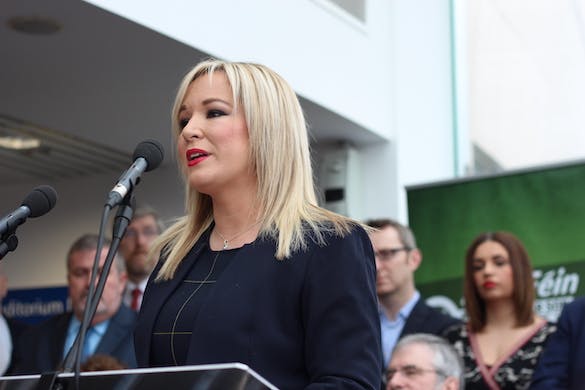In Northern Ireland, a Catholic Plurality Revives Dreams of Unification
New data show that there are now more Catholics than Protestants in Northern Ireland, and the question is whether partition will hold.

New data showing that there are now more Catholics than Protestants in Northern Ireland augurs further turbulence in that troubled region, raising the question of whether partition will hold and reviving dreams for a united Ireland.
The demographic dynamite arrives via the just released results of the 2021 census, which show that 45.7 percent of Northern Ireland’s inhabitants are Catholic or from a Catholic background, compared with 43.5 percent from Protestant or other Christian backgrounds. A decade ago, 45 percent were Catholic and 48 percent were Protestant.
The reality that religion and politics are not directly correlated is evinced by the truth that there are Catholic unionists and Protestant republicans. Decades of peace have softened some of the sharp edges of sectarianism. Nevertheless, the changing religious complexion of Northern Ireland is a dramatic development given the bloody history of the Emerald Isle.
When Northern Ireland was created under the Government of Ireland Act 1920, it was engineered to be a Protestant stronghold, unlike the Catholic redoubts in the south. Two-thirds of Northern Ireland inhabitants were not of the pontiff’s party.
Due to higher Catholic birth rates, however, that identity has now eroded and given way to visions of an Ireland that stretches between Cork and Donegal.
In another sign of change, Sinn Féin, the political party with radical roots that has long been the vehicle for a united Ireland, garnered the most seats in a spring vote for Northern Ireland’s assembly, the Stormont. It displaced the Democratic Unionist Party, a Protestant faction deeply committed to union with Britain.
That result and the DUP’s refusal to join the government until Prime Minister Truss renegotiates the Northern Ireland protocol — a post-Brexit agreement that some at Belfast view as too solicitous to the European Union — has left Northern Irish politics at a standstill.
At the United Nations this week, Ms. Truss, who has supported legislation that would give Westminster the ability unilaterally to amend the protocol, discussed the issue with both President Biden and European Commission’s president, Ursula von der Leyen, according to the BBC. Both have urged fidelity to the status quo.
The aftershocks of Brexit and the passing of Elizabeth II and Ms. Truss’s move to 10 Downing Street have occasioned reflection on the shape of the United Kingdom, from Belfast and Cardiff to Edinburgh, where a vote on Scottish independence is scheduled for October 2023. An August poll shows support for Welsh independence at 30 percent, and rising.
A century after the Irish War of Independence, some have begun to contemplate an even larger alteration to the status quo. They look to the Good Friday Agreement, which ended the decades of bloodshed between Protestants and Catholics known as “the Troubles.” The greater part of that violence transpired in Northern Ireland.
That accord allows for the secretary of state for Northern Ireland, who sits at Westminster, to call for a unification referendum “if at any time it appears likely to him that a majority of those voting would express a wish that Northern Ireland should cease to be part of the United Kingdom and form part of a united Ireland.”
The leader of Sinn Fein in Northern Ireland, Michelle O’Neill, reacted to the Catholic ascendancy in Northern Ireland by calling it “another clear indication that historic change is happening across this island and of the diversity of society which enriches us all.”
Members of Ms. O’Neill’s party, whose roots lie in the political wing of the Irish Republican Army paramilitary group, has been known to shout and graffiti Tiocfaidh ár lá, which translates as “our day will come,” a reference to a united Ireland. The phrase originated with such republicans as the martyred Bobby Sands and Gerry Adams, the revolutionary and lawmaker.
The Irish constitution, adopted in 1998, “recognises that a united Ireland shall be brought about only by peaceful means with the consent of a majority of the people, democratically expressed, in both jurisdictions in the island.”
A 2021 poll from the Irish Times/Ipsos found support for unification to be above 60 percent in the Republic of Ireland. While that number is below 50 percent in Northern Ireland, trend lines indicate that percentage is climbing in the post-Brexit era.

